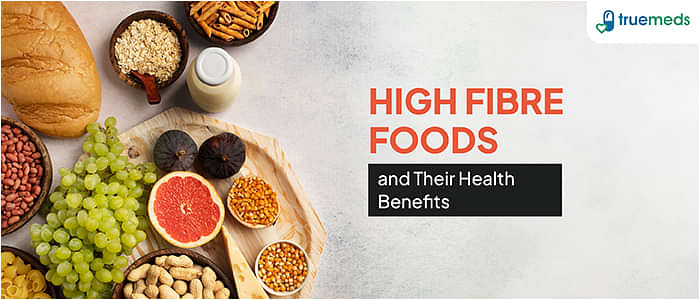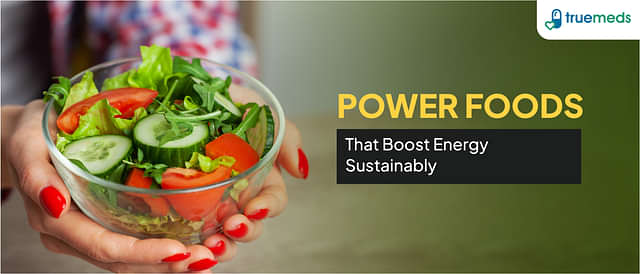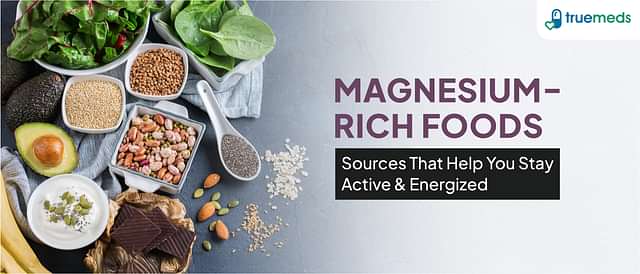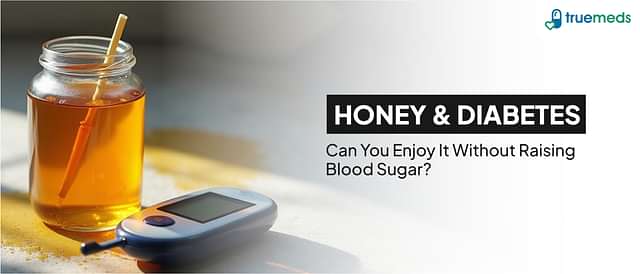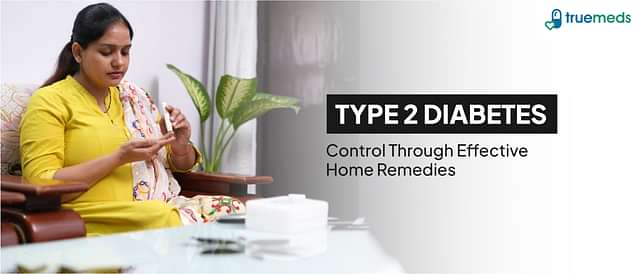17 High-Fibre Foods to Include in Your Daily Diet
Last updated on : 21 Mar, 2025
Read time : 9 min
Introduction
We all know that a balanced diet is key to good health. But how often do we consider fibre as a crucial part of our daily intake? Dietary fibre, found in foods we eat daily like fruits, vegetables, and whole grains, is known for its many health benefits. Despite being indigestible by the human body, dietary fibre plays an essential role in maintaining our digestive health. It has even been linked to a reduced risk of several chronic diseases. The understanding of what is fibre and its importance has evolved over time, with definitions and classifications becoming more precise to better reflect its complex nature and physiological effects.
What is Dietary Fibre?
Simply put, dietary fibre refers to the parts of plant foods that our bodies can’t digest or absorb. This might make it seem unimportant but on the contrary, it plays a vital role in our health. Dietary fibre consists of non-starch polysaccharides and other plant components that are resistant to digestion by our enzymes. It can be categorised into two main types: soluble fibre and insoluble fibre.
Understanding dietary fibre is important for us all. Incorporating fibre-rich fruits, vegetables, and other high-fibre foods in your diet can help alleviate issues like constipation and contribute significantly to your overall wellbeing.
In this article, we explore the top high-fibre foods commonly found in India, and how to seamlessly integrate these dietary fibre rich foods into your everyday diet.
How Much Dietary Fibre Do You Need Daily?
The recommended daily intake of dietary fibre depends upon your age and gender. Here’s a simple breakdown:
| Age range & gender | Recommended fibre intake per day |
| Adult men | 34 grams |
| Adult women | 28 grams |
| Children aged 1 to 3 years | 14 grams |
| Kids aged 4 to 8 years | 16.8–19.6 grams |
| Adolescents aged 9 to 13 years | 22.4–25.2 grams |
| Teenagers aged 14 to 18 years | 25.2–30.8 grams |
However, most people manage to consume far less than these recommended amounts. To meet your daily fibre needs and maintain good health, it is crucial to include a variety of fibre-rich foods in your diet.
Types of Dietary Fibres
Dietary fibre is essential for our health, but did you know there are two distinct types – insoluble and soluble fibre? Understanding what these are, how they work and where to find them can help us make better dietary choices.
Insoluble fibres
Insoluble fibre is the tough guy in the fibre family. It does not dissolve in water and its main job is to promote regular bowel movements and prevent constipation. The great thing about insoluble fibre is that it adds bulk to our stools and helps food move swiftly through our digestive tract. This not only prevents constipation but can also help reduce the risk of colon cancer.
Soluble fibres
Soluble fibre, on the other hand, is more of a softie. It dissolves in water, forming a gel-like substance in the digestive system. This unique property helps slow down the absorption of sugars, allowing us to maintain steady blood sugar levels and possibly reducing the risk of heart disease. The nice thing about soluble fibre is that it’s fermented by gut bacteria, promoting a healthy microbiome which is beneficial for overall health.
High Fibre Foods to Add to Your Diet
A key component of a healthy diet is dietary fibre. It aids in digestion, helps control blood sugar levels, and can even reduce the risk of heart disease. Let’s explore some of the high fibre foods you can add to your diet.
Whole Grains
Whole grains are an excellent source of fibre because they contain all parts of the grain — the bran, germ, and endosperm.
1. Oats
Oats are an excellent choice for a high-fibre breakfast. They’re rich in beta-glucan, a type of soluble fibre that helps reduce cholesterol and improve heart health. A single serving of cooked oats gives you around 4 grams of fibre.
2. Quinoa
Quinoa is not just a complete protein source but also packs in approximately 5 grams of fibre per cooked cup. Plus, it’s gluten-free, making it a great choice for those with dietary restrictions.
3. Brown Rice
Switching to brown rice from the white variant can significantly boost your fibre intake. A cup of cooked brown rice provides about 3.5 grams of fibre.
4. Legumes
When it comes to high fibre content, legumes are superstars. They’re also packed with protein, making them an excellent food choice for vegetarians and vegans.
5. Lentils
Incredibly versatile lentils provide about 7.8 grams of fibre per half-cup when cooked. You can add them to your soups, salads, and even stews.
6. Chickpeas
Also known as garbanzo beans, chickpeas offer around 6.3 grams of fibre per half cup when cooked. You can use them to make hummus or add them to salads.
7. Black Beans
Black beans make for a hearty addition to any meal and provide around 7.5 grams of fibre per half-cup when cooked. They’re great in Mexican cuisine.
Vegetables
Vegetables are low in calories and high in fibre, making them a key part of any healthy diet.
1. Broccoli
Broccoli is not only abundant in vitamins and antioxidants, but it also provides about 5 grams of fibre per cooked cup.
2. Brussels Sprouts
Brussels sprouts make for a delicious side dish and provide approximately 4 grams of fibre per cooked cup.
3. Carrots
Raw carrots are not just a crunchy snack but also give you about 3.5 grams of fibre per cup.
Fruits
Fibre rich fruits serve as an excellent source of essential vitamins, minerals, and of course, fibre.
1. Apples
An average-sized apple with the skin on offers about 4.5 grams of fibre. It’s a perfect on-the-go snack.
2. Pears
Pears are another fruit species rich in fibre. A medium-sized pear provides about 5.5 grams of fibre.
3. Berries (Raspberries, Blackberries)
Berries are a sweet treat that’s high in fibre. A cup of raspberries offers about 8 grams of fibre, while the same serving size of blackberries provides around 7.6 grams.
Nuts and Seeds
Nuts and seeds provide not only fibre but also healthy fats and protein.
1. Chia Seeds
Chia seeds might be small in size, but they’re mighty in terms of nutritional value. They provide a staggering 10 grams of fibre per ounce.
2. Flaxseeds
Ground flaxseeds make for an easy-to-use fibre-rich addition to your cereals or smoothies, providing about 3 grams of fibre per tablespoon.
3. Almonds
Almonds are a healthy snack option that gives you about 3.5 grams of fibre per ounce.
Other High-Fibre Foods
Looking beyond the usual categories, there are other foods high in fibre that you can include in your diet.
1. Avocados
Avocados are unique fruits offering about 10 grams of fibre per medium-sized avocado. They’re also rich in healthy fats.
2. Sweet Potatoes
A medium-sized sweet potato, especially when consumed with the skin, provides about 4 grams of fibre. You can bake, mash, or add them to stews.
3. Popcorn
Lastly, who would have thought that your favourite movie-time snack is a good source of fibre? Air-popped popcorn provides about 3.5 grams of fibre per 3-cup serving.
Including an assortment of these high-fibre foods in your daily diet can help you meet your fibre requirements and promote overall health.
Also Read: Low-Calorie Foods
Side Effects of Too Much Fibre Consumption
While fibre is beneficial in regulating our digestive system and maintaining overall health, excessive consumption can lead to a series of side effects. Here are some of the problems that may arise if you consume too much fibre:
- Stomach issues: Consuming high amounts of fibre can lead to abdominal discomfort, bloating, gas and cramping. This is because fibre-rich foods take longer to digest and an abrupt increase can overburden your digestive system.
- Low absorption of nutrients: Overeating fibre-rich foods in your diet can obstruct the absorption of essential nutrients like calcium, iron, and zinc. This could potentially lead to deficiencies and health issues like osteoporosis and anaemia.
- Diarrhoea: An immediate hike in fibre intake can cause diarrhea or loose stools. This is notably common when consuming high amounts of soluble fibre, which attracts water into your intestine and softens the stools excessively.
- Intestinal issues: If you consume too much fibre without adequate fluid intake, you might face intestinal blockages- a serious condition that requires immediate medical attention.
- Constipation: Having high fibre foods for constipation is often recommended, however, an overload without sufficient fluid intake can actually cause constipation.
- Anal fissures: Consuming a lot of fibre can result in hard stools, leading to anal fissures- small tears in the lining of the anus that can be painful and may necessitate medical attention.
To sidestep these side effects, it’s advisable to gradually increase your fibre intake while ensuring you remain well-hydrated. Consuming a blend of different sources of fibre helps balance the proportion of soluble and insoluble fibres effectively.
Conclusion
Dietary fibre plays an integral role in fostering our overall health and well-being. It aids digestion, helps manage blood sugar levels, lowers cholesterol and contributes to weight control. Incorporating a balance of both soluble and insoluble fibres will support a healthy digestive system. Incorporating a range of high fibre foods in India such as whole grains, legumes, fruits, vegetables, nuts and seeds into your daily diet not only helps meet the recommended dietary fibre intake but also offers numerous health advantages.
Frequently Asked Questions (FAQs)
Dietary fibre aids digestion, helps maintain a healthy weight, and can lower the risk of diabetes and heart disease.
Signs include constipation, unexplained weight gain, and feeling unsatisfied after meals.
Yes, several high-fibre foods like green leafy vegetables, avocados, and chia seeds are low in carbs.
A: High fibre fruits like apples and pears, almonds, popcorn, and whole grain crackers are excellent choices.
Yes, fibre rich foods like vegetables and fruits can help you feel full longer, aiding in weight loss.
While supplements can help, it’s best to consume dietary fibre foods like vegetables and whole grains.
Disclaimer
Our healthcare experts have carefully reviewed and compiled the information presented here to ensure accuracy and trustworthiness. It is important to note that this information serves as a general overview of the topic and is for informational purposes only. It is not intended to diagnose, prevent, or cure any health problem. This page does not establish a doctor-patient relationship, nor does it replace the advice or consultation of a registered medical practitioner. We recommend seeking guidance from your registered medical practitioner for any questions or concerns regarding your medical condition.
Popular Articles
Recommended Articles
Recent Articles
Top-Selling Medicines:
...View more
Top-Selling OTC:
...View more
Subscribe
Registered Office Address
Grievance Officer
Download Truemeds

Contact Us
Our customer representative team is available 7 days a week from 9 am - 9 pm.
v3.7.5
Our Payment Partners









